| What Is It? Click on the image or underlined text for a larger picture. Grover, Waverly and Elton made most of the hardware and ephemera for the musical instrument industry, but which one (or some other manufacturer) made the unnamed pieces may never be known unless a vintage catalog turns up from one or more of the companies.
|
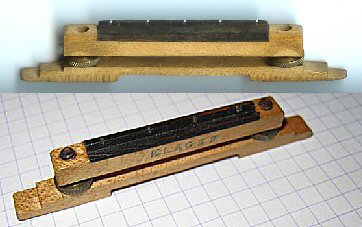 Adjustable Banjo Bridges 5-string version courtesy of Len Crossman. 4-string version courtesy of Bruce Krivisky. The one marked KLUGES is the first indication of the maker or seller. Has anyone seen an ad or other indication of who made it or sold it and when? Please let me know. MIH Adjustable Banjo Bridges 5-string version courtesy of Len Crossman. 4-string version courtesy of Bruce Krivisky. The one marked KLUGES is the first indication of the maker or seller. Has anyone seen an ad or other indication of who made it or sold it and when? Please let me know. MIH
|
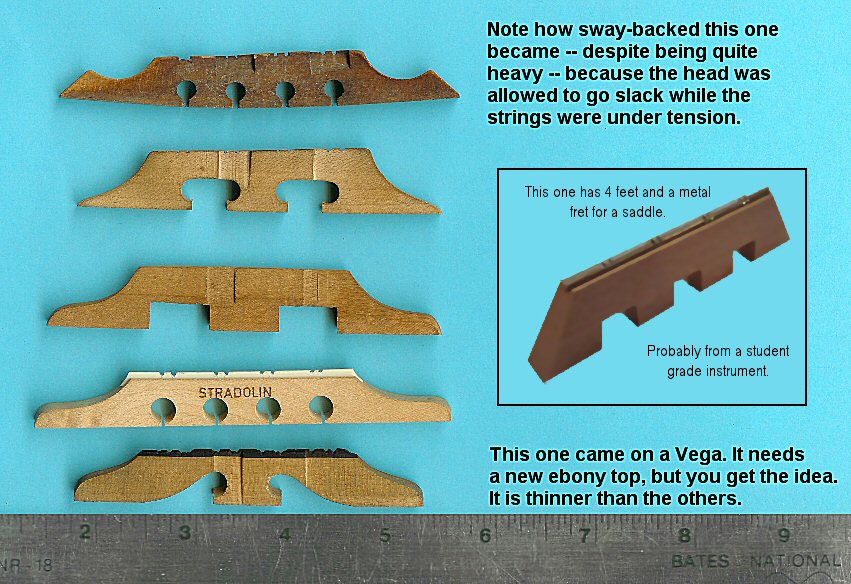 Banjo mandolin bridges a variety of styles from the teens to the 30s. Earlier ones tended to be wider -- end to end -- but not thicker, and seldom with any compensation.. Banjo mandolin bridges a variety of styles from the teens to the 30s. Earlier ones tended to be wider -- end to end -- but not thicker, and seldom with any compensation..
|
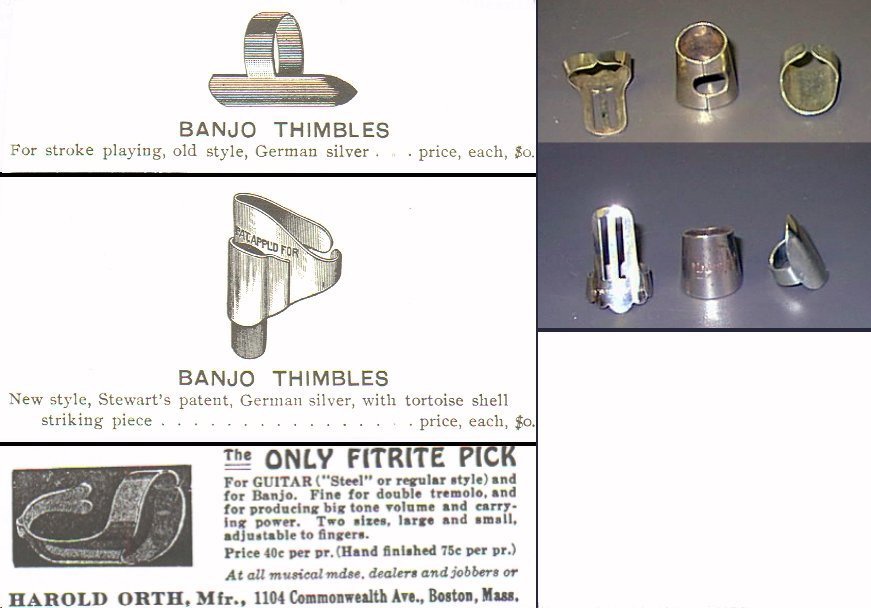 Banjo thimbles Banjo Thimbles or Finger picks. 2 1890s Stewarts and one 1920s "Fitrite." Color photos by Hank Schwartz. Banjo thimbles Banjo Thimbles or Finger picks. 2 1890s Stewarts and one 1920s "Fitrite." Color photos by Hank Schwartz.
|
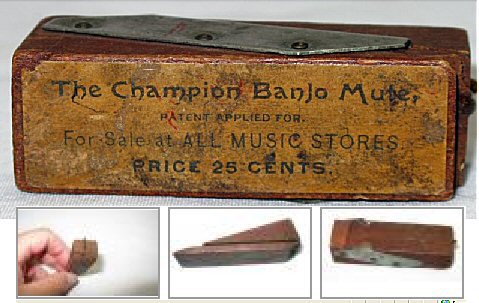 Champion Banjo Mute The two wooden, wedge-shaped pieces slide apart to adjust the tension against the head. Stamped "Patent Applied For" no such patent has been found. The price, 25 cents, must have seemed like a lot of money at a time when a banjo could be purchased for a few dollars. Champion Banjo Mute The two wooden, wedge-shaped pieces slide apart to adjust the tension against the head. Stamped "Patent Applied For" no such patent has been found. The price, 25 cents, must have seemed like a lot of money at a time when a banjo could be purchased for a few dollars.
|
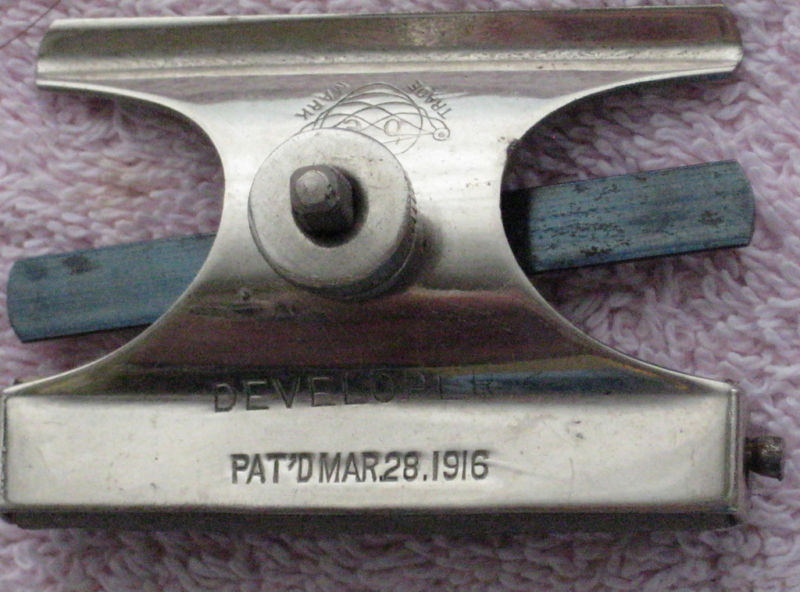 Developer Mute patent issued 3/28/1916 to and marketed as a "Roller Mute" by Dennis Hartnett, developer of other accessories including an adjustable arm rest and knee rest. Developer Mute patent issued 3/28/1916 to and marketed as a "Roller Mute" by Dennis Hartnett, developer of other accessories including an adjustable arm rest and knee rest.
|
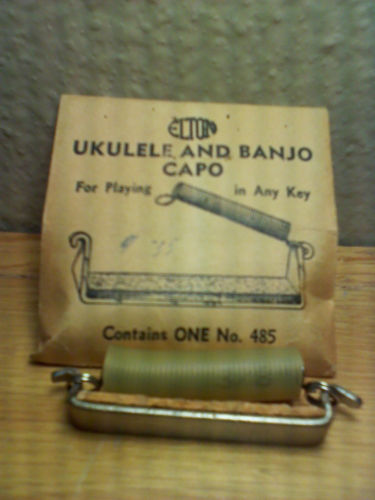 Elton Banjo and Uke Capo the covering was either non-existent or quickly wore through and the spring tore the finish off the neck, but it was the first capo many players had.. Elton Banjo and Uke Capo the covering was either non-existent or quickly wore through and the spring tore the finish off the neck, but it was the first capo many players had..
|
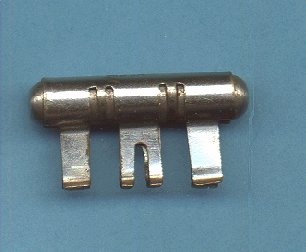 Elton Banjo Mute clips on the bridge to increase its weight, thus changing the tone to be "thinner" and the volume quieter. Elton Banjo Mute clips on the bridge to increase its weight, thus changing the tone to be "thinner" and the volume quieter.
|
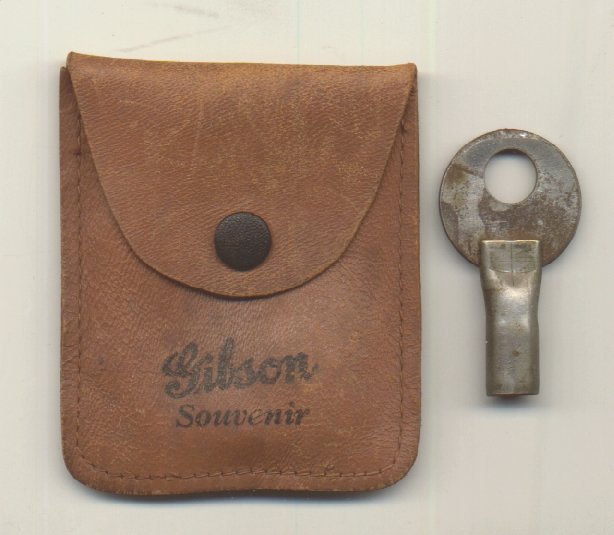 Gibson Souvenir Pouch Whether a give-away or a purchse item is not know. Gibson Souvenir Pouch Whether a give-away or a purchse item is not know.
|
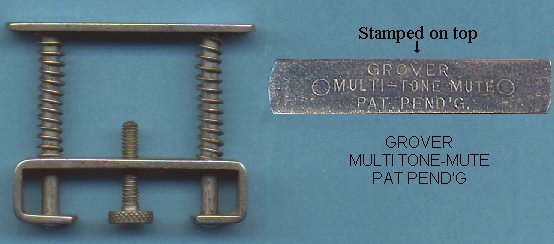 Grover Multi-Tone-Mute. Adjust the tension between the wooden "perch pole" and the head and slide the mute back qnd forth to change the tone, hence the name. It doesn't work so well with a metal coordinator rod. Grover Multi-Tone-Mute. Adjust the tension between the wooden "perch pole" and the head and slide the mute back qnd forth to change the tone, hence the name. It doesn't work so well with a metal coordinator rod.
|
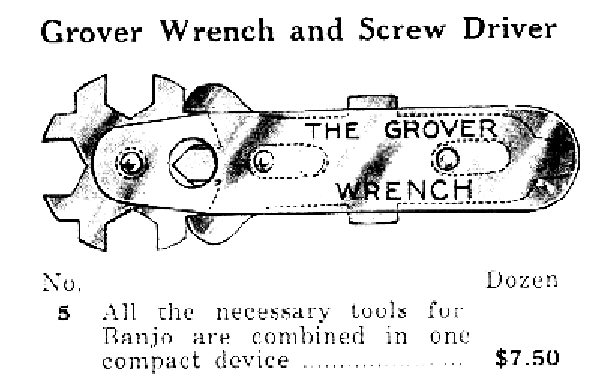 Grover Multi-Wrench. Again the picture says it all! The one tool replaces 4 wrenches and a screwdriver. Grover Multi-Wrench. Again the picture says it all! The one tool replaces 4 wrenches and a screwdriver.
|
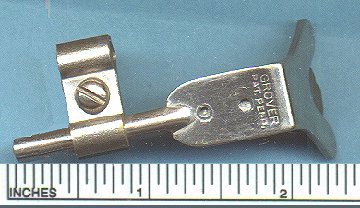 Grover Pick Holder attaches to a banjo hook and holds your pick when not in use. Patented by John Martell, 1/26/1926 and sold by Grover. Grover Pick Holder attaches to a banjo hook and holds your pick when not in use. Patented by John Martell, 1/26/1926 and sold by Grover.
|
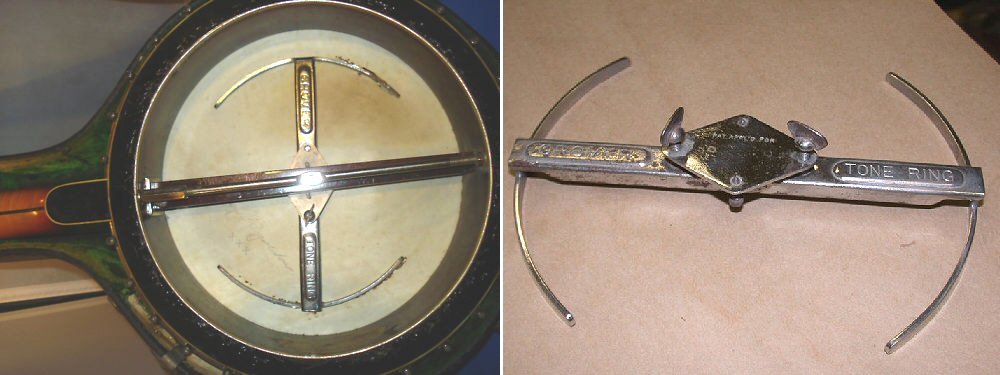 Grover Tone Ring goes between the strut and the head. Thumbscrews adjust tension against the head, effectively change a flathead to an archtop. Grover Tone Ring goes between the strut and the head. Thumbscrews adjust tension against the head, effectively change a flathead to an archtop.
|
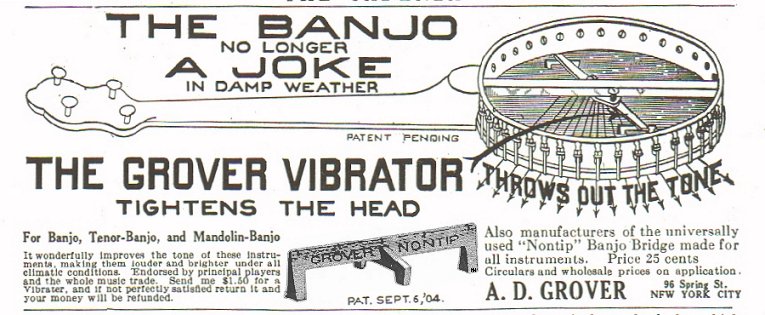 Grover Vibrator May, 1917 advertisement showing placement and explanation of function. Grover Vibrator May, 1917 advertisement showing placement and explanation of function.
|
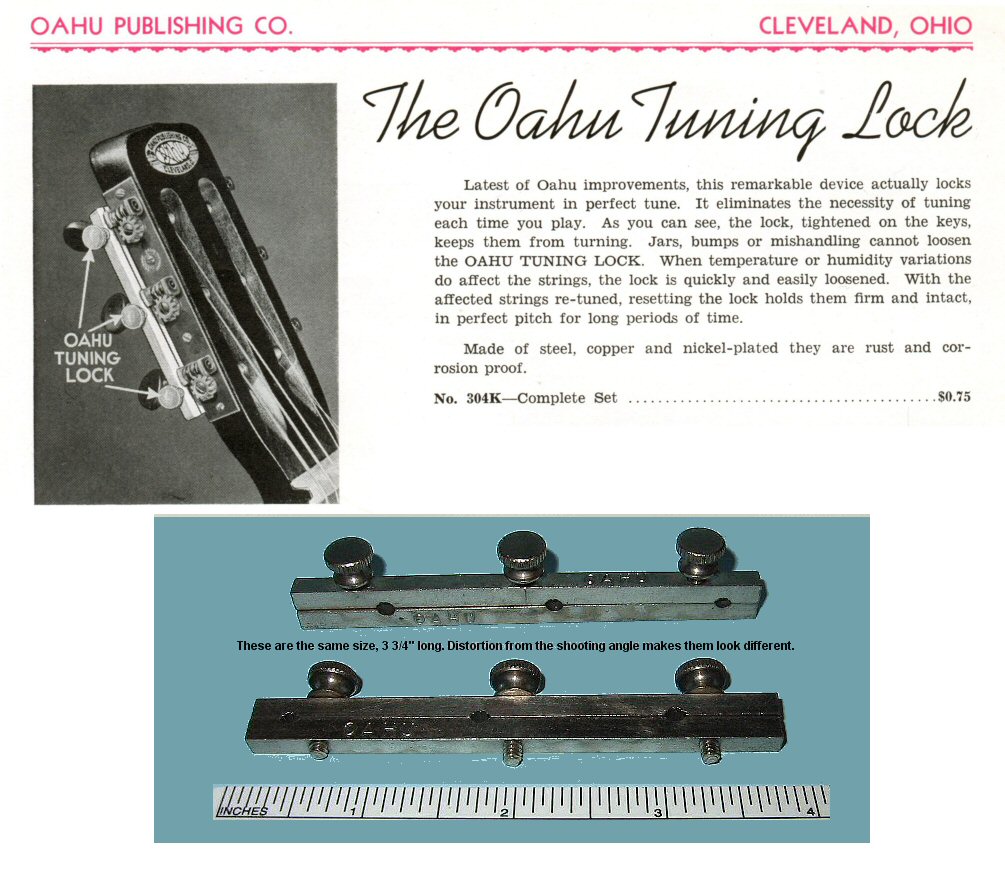 Oahu marked "clamps." Thanks to Frank Nordberg -- he has confirmed my surmise. "This gadget was called the Oahu Tuning Lock and first appeared in Catalog 24 (1940) at 75 cents a pair. They're listed in catalogs 25 (1941) and 26 (1944) at the same price. Frank.". Oahu marked "clamps." Thanks to Frank Nordberg -- he has confirmed my surmise. "This gadget was called the Oahu Tuning Lock and first appeared in Catalog 24 (1940) at 75 cents a pair. They're listed in catalogs 25 (1941) and 26 (1944) at the same price. Frank.".
|
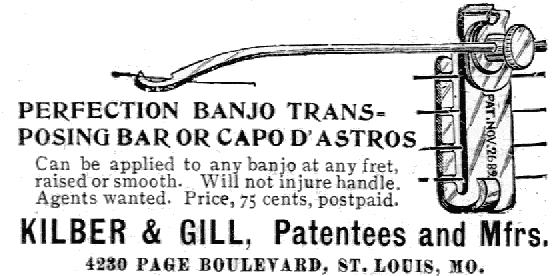 Perfection Banjo Transposing Bar. The picture says it all! Patented by Kilber & Gill in 1889, it eliminated the need to retune the 5th string, a problem that persists to this day. The ad is from Cadenza magazine, May-June, 1900 issue. Perfection Banjo Transposing Bar. The picture says it all! Patented by Kilber & Gill in 1889, it eliminated the need to retune the 5th string, a problem that persists to this day. The ad is from Cadenza magazine, May-June, 1900 issue.
|
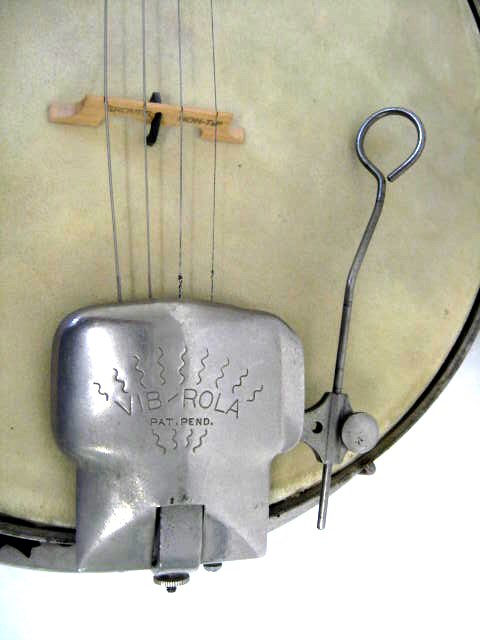 Vibrola Tailpiece. Move the metal rod to add vibrato to your playing. Maker unknown. Vibrola Tailpiece. Move the metal rod to add vibrato to your playing. Maker unknown.
|
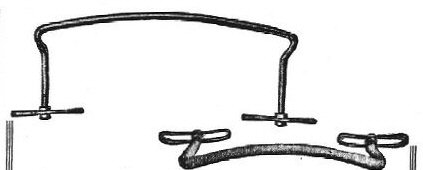 Wilmot & Wood Armrests & Kneerests were sold as accessories and, by many companies, as part of the original equipment on a banjo. They were probably not manufacturers but instead contracted with others to make and label things for them. Wilmot & Wood Armrests & Kneerests were sold as accessories and, by many companies, as part of the original equipment on a banjo. They were probably not manufacturers but instead contracted with others to make and label things for them.
|
 Adjustable Banjo Bridges 5-string version courtesy of Len Crossman. 4-string version courtesy of Bruce Krivisky. The one marked KLUGES is the first indication of the maker or seller. Has anyone seen an ad or other indication of who made it or sold it and when? Please let me know. MIH
Adjustable Banjo Bridges 5-string version courtesy of Len Crossman. 4-string version courtesy of Bruce Krivisky. The one marked KLUGES is the first indication of the maker or seller. Has anyone seen an ad or other indication of who made it or sold it and when? Please let me know. MIH
 Banjo mandolin bridges a variety of styles from the teens to the 30s. Earlier ones tended to be wider -- end to end -- but not thicker, and seldom with any compensation..
Banjo mandolin bridges a variety of styles from the teens to the 30s. Earlier ones tended to be wider -- end to end -- but not thicker, and seldom with any compensation..
 Banjo thimbles Banjo Thimbles or Finger picks. 2 1890s Stewarts and one 1920s "Fitrite." Color photos by Hank Schwartz.
Banjo thimbles Banjo Thimbles or Finger picks. 2 1890s Stewarts and one 1920s "Fitrite." Color photos by Hank Schwartz.
 Champion Banjo Mute The two wooden, wedge-shaped pieces slide apart to adjust the tension against the head. Stamped "Patent Applied For" no such patent has been found. The price, 25 cents, must have seemed like a lot of money at a time when a banjo could be purchased for a few dollars.
Champion Banjo Mute The two wooden, wedge-shaped pieces slide apart to adjust the tension against the head. Stamped "Patent Applied For" no such patent has been found. The price, 25 cents, must have seemed like a lot of money at a time when a banjo could be purchased for a few dollars.
 Developer Mute patent issued 3/28/1916 to and marketed as a "Roller Mute" by Dennis Hartnett, developer of other accessories including an adjustable arm rest and knee rest.
Developer Mute patent issued 3/28/1916 to and marketed as a "Roller Mute" by Dennis Hartnett, developer of other accessories including an adjustable arm rest and knee rest.
 Elton Banjo and Uke Capo the covering was either non-existent or quickly wore through and the spring tore the finish off the neck, but it was the first capo many players had..
Elton Banjo and Uke Capo the covering was either non-existent or quickly wore through and the spring tore the finish off the neck, but it was the first capo many players had..
 Elton Banjo Mute clips on the bridge to increase its weight, thus changing the tone to be "thinner" and the volume quieter.
Elton Banjo Mute clips on the bridge to increase its weight, thus changing the tone to be "thinner" and the volume quieter.
 Gibson Souvenir Pouch Whether a give-away or a purchse item is not know.
Gibson Souvenir Pouch Whether a give-away or a purchse item is not know.
 Grover Multi-Tone-Mute. Adjust the tension between the wooden "perch pole" and the head and slide the mute back qnd forth to change the tone, hence the name. It doesn't work so well with a metal coordinator rod.
Grover Multi-Tone-Mute. Adjust the tension between the wooden "perch pole" and the head and slide the mute back qnd forth to change the tone, hence the name. It doesn't work so well with a metal coordinator rod.
 Grover Multi-Wrench. Again the picture says it all! The one tool replaces 4 wrenches and a screwdriver.
Grover Multi-Wrench. Again the picture says it all! The one tool replaces 4 wrenches and a screwdriver.
 Grover Pick Holder attaches to a banjo hook and holds your pick when not in use. Patented by John Martell, 1/26/1926 and sold by Grover.
Grover Pick Holder attaches to a banjo hook and holds your pick when not in use. Patented by John Martell, 1/26/1926 and sold by Grover.
 Grover Tone Ring goes between the strut and the head. Thumbscrews adjust tension against the head, effectively change a flathead to an archtop.
Grover Tone Ring goes between the strut and the head. Thumbscrews adjust tension against the head, effectively change a flathead to an archtop.
 Grover Vibrator May, 1917 advertisement showing placement and explanation of function.
Grover Vibrator May, 1917 advertisement showing placement and explanation of function.
 Oahu marked "clamps." Thanks to Frank Nordberg -- he has confirmed my surmise. "This gadget was called the Oahu Tuning Lock and first appeared in Catalog 24 (1940) at 75 cents a pair. They're listed in catalogs 25 (1941) and 26 (1944) at the same price. Frank.".
Oahu marked "clamps." Thanks to Frank Nordberg -- he has confirmed my surmise. "This gadget was called the Oahu Tuning Lock and first appeared in Catalog 24 (1940) at 75 cents a pair. They're listed in catalogs 25 (1941) and 26 (1944) at the same price. Frank.".
 Perfection Banjo Transposing Bar. The picture says it all! Patented by Kilber & Gill in 1889, it eliminated the need to retune the 5th string, a problem that persists to this day. The ad is from Cadenza magazine, May-June, 1900 issue.
Perfection Banjo Transposing Bar. The picture says it all! Patented by Kilber & Gill in 1889, it eliminated the need to retune the 5th string, a problem that persists to this day. The ad is from Cadenza magazine, May-June, 1900 issue.
 Vibrola Tailpiece. Move the metal rod to add vibrato to your playing. Maker unknown.
Vibrola Tailpiece. Move the metal rod to add vibrato to your playing. Maker unknown.
 Wilmot & Wood Armrests & Kneerests were sold as accessories and, by many companies, as part of the original equipment on a banjo. They were probably not manufacturers but instead contracted with others to make and label things for them.
Wilmot & Wood Armrests & Kneerests were sold as accessories and, by many companies, as part of the original equipment on a banjo. They were probably not manufacturers but instead contracted with others to make and label things for them.